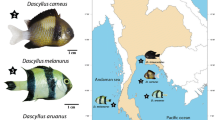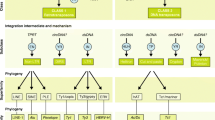Abstract
Widely regarded beliefs aboutDrosophila histone gene copy numbers and developmental requirements have been generalized from fairly limited data since studies on histone gene arrangements and copy numbers have been largely confined to a single species,D. melanogaster. Histone gene copy numbers and chromosomal locations were examined in three species:D. melanogaster, D. hydei andD. hawaiiensis. Quantitative whole genome blot analysis of DNA from diploid tissues revealed a tenfold variability in histone gene copy numbers for these three species. In situ hybridization to polytene chromosomes showed that the histone DNA (hDNA) chromosomal location is different in all three species. These observations lead us to propose a relationship between histone gene reiteration and chromosomal position.
Similar content being viewed by others
References
Anderson V, Lengyel A (1980) Changing rates of histone mRNA synthesis and turnover in Drosophila embryos. Cell 21:717–727
Anderson KV, Lengyel JA (1984) Histone gene expression in Drosophila development: Multiple levels of gene regulation. In: Stein GS, Stein JL, Marzluff WE (eds) Histone genes: Structure, organization, and regulation. John Wiley & Sons, New York, pp 135–161
Ashburner M (1970) Function and structure of polytene chromosomes during insect development. Adv Insect Physiol 7:1–95
Berendes HD (1963) The salivary gland chromosomes ofDrosophila hydei Sturtevant. Chromosoma 14:195–206
Daniels SB, Strausbaugh LD (1986) The distribution of P-element sequences inDrosophila: the willistoni and saltans species groups. J Mol Evol 23:138–148
Denhardt DT (1966) A membrane-filter technique for the detection of complementary DNA. Biochem Biophys Res Commun 23:641–646
Dickson E, Boyd JB, Laird CD (1971) Sequence diversity of polytene chromosome DNA fromD. hydei. J Mol Biol 61:615–628
Domier LL, Rivard JJ, Sabatini LM, Blumenfeld M (1986)Drosophila virilis histone gene clusters lacking H1 coding segments. J Mol Evol 23:149–158
Engel JD, Dodgson JB (1981) Histone genes are clustered but not tandemly repeated in the chicken genome. Proc Natl Acad Sci USA 78:2856–2860
Feinberg AP, Vogelstein B (1984) A technique for radiolabeling DNA restriction endonuclease fragments to high specific activity. Anal Biochem 137:266–267
Fitch DHA (1986) Characterization of the histone genes ofDrosophila hydei. PhD Thesis, The University of Connecticut
Graves R, Marzluff F, Giebelhaus DH, Schultz GA (1985) Quantitative and qualitative change in histone gene expression during early mouse embryo development. Proc Natl Acad Sci USA 82:5685–5689
Halsell SR, Ito M, Maxson R (1987) Differential expression of early and late embryonic histone genes in adult tissues of the sea urchinStrongylocentrotus purpuratus. Dev Biol 119:268–274
Hazelrigg T, Levis R, Rubin R (1985) Transformation of white Locus DNA inDrosophila: Dosage compensation, zeste interaction, and position effects. Cell 36:469–481
Hinegardner RT (1967) Methods in developmental biology. In: Wilft FH, Wessels NK (eds) Echinoderms. Crowell-Collier, New York, p 139
Hyashi S, Gillam IC, Delaney AD, Tener GH (1978) Acetylation of chromosome squashes ofDrosophila melanogaster decreases the background in autoradiographs from hybridization with [125I]-labeled RNA. J Histochem Cytochem 26:677–697
Jacob E, Malacinski G, Birnstiel ML (1976) Reiteration frequency of the histone genes in the genome of the amphibian,Xenopus laevis. Eur J Biochem 69:45–54
Karpen GH, Schaefer JH, Laird CD (1988) A Drosophila rRNA gene located in euchromatin is active in transcription and nucleolus formation. Genes Dev 2:1745–1763
Kedes LH (1979) Histone genes and histone messengers. Annu Rev Biochem 48:837–870
Kedes LH, Birnstiel ML (1971) Reiteration and clustering of DNA sequences complementary to histone messenger RNA. Nature New Biol 230:165–169
Kim YJ, Hwant I, Tres L, Kierszenbaum AL, Chae CB (1987) Molecular cloning and differential expression of somatic and testis-specific H2B histone genes during rat spermatogenesis. Dev Biol 124:23–24
Kissane JM, Robbins E (1958) The fluorometric measurement of deoxyribonucleic acid in animal tissues with special reference to the central nervous system. J Biol Chem 233:184–188
Kornberg A (1974) DNA replication. Freeman, San Francisco, CA
Kunkel NS, Weinberg ES (1978) Histone gene transcripts in the cleavage and mesenchyme blastula embryo of the sea urchin,S. purpuratus. Cell 14:313–326
LaBella F, Zhong R, Heintz N (1988) Cell type-specific expression of a human histone H1 gene. J Biol Chem 263:2115–2118
Lieber T, Weisser K, Childs J (1986) Analysis of histone gene expression in adult tissues of the sea urchinsStrongylocentrotus purpuratus andLytechinus pictus: tissue-specific expression of sperm histone genes. Mol Cell Biol 6:2602–2612
Lifton RP, Goldberg ML, Karp RW, Hogness DS (1978) The organization of the histone genes inDrosophila melanogaster: Functional and evolutionary implications. Cold Spring Harbor Symp Quant Biol 42:1047–1051
Maniatis T, Fritsch EF, Sambrook J (1982) Molecular cloning, Cold Spring Harbor Laboratory, Cold Spring Harbor, NY
Marzluff WF, Graves RA (1984) Organization and expression of mouse histone genes. In: Stein S, Stein L, Marzluff WF (eds) Histone genes: structure, organization and regulation. John Wiley and Sons, New York, pp 339–371
Narayanswami S, Hamkalo BA (1986) Electron microscopic in situ hybridization using biotinylated probes. Focus 8, 3–6
Newrock KM, Cohen LH, Hendricks MB, Donnelly RJ, Weinberg ES (1978) Stage-specific mRNAs coding for subtypes of H2A and H2B histones in the sea urchin embryo. Cell 14:327–336
Old RW, Woodland HR (1984) Histone genes: Not so simple after all. Cell 38:624–626
Overton GC, Weinberg ES (1978) Length and sequence heterogeneity of the histone gene repeat unit of the sea urchin,S. purpuratus. Cell 14:247–257
Pardue ML, Gall JG (1975) Nucleic acid hybridization to the DNA of cytological preparations. Methods Cell Biol 1–16
Pardue ML, Brown DD, Birnstiel ML (1973) Location of the genes for 5S ribosomal RNA inXenopus laevis. Chromosoma 42:191–203
Pardue ML, Kedes LH, Weinberg ES, Birnstiel M (1977) Localization of sequences coding for histone messenger RNA in the chromosomes ofDrosophila melanogaster. Chromosoma 63:135–151
Rasch EM, Barr HJ, Rasch RW (1971) The DNA content of sperm ofD. melanogaster. Chromosoma 33:1–18
Ruddell A, Jacobs-Lorena M (1985) Biphasic pattern of histone gene expression duringDrosophila oogenesis. Proc Natl Acad Sci USA 82:3316–3319
Southern EM (1975) Detection of specific sequences among DNA fragments separated by gel electrophoresis J Mol Biol 98:503–517
Spear BB (1977) Differential replication of DNA sequences inDrosophila chromosomes. Am Zool 17:695–706
Spear BB, Gall JG (1973) Independent control of ribosomal gene replication in polytene chromosomes ofDrosophila melanogaster. Proc Natl Acad Sci USA 70:1359–1363
Spofford JB (1976) Position-effect variegation inDrosophila. In: Ashburner M, Novitski E (eds) The genetics and biology ofDrosophila, vol. 1 c. Academic Press, New York, pp 955–1018
Stein GS, Sierra F, Stein JL, Plumb M, Mareshi F, Carozzi N, Prokopp K, Baumbach L (1984) Organization and expression of human histone genes. In: Stein GS, Stein JL, Marzluff WF (eds) Histone genes: Structure, organization and regulation. John Wiley and Sons, New York, pp 397–456
Stephenson EC (1984) Organization and expression of newt histone genes. In: Stein GS, Stein JL, Marzluff WF (eds) Histone genes: Structure, organization and regulation. John Wiley and Sons, New York, pp 225–242
Stephenson EC, Erba HP, Gall JG (1981) Histone gene clusters of the newt Notophthalmus are separated by long tracts of satellite DNA. Cell 24:639–647
Strausbaugh LD, Weinberg ES (1979) Heterogeneity in histone gene organization inDrosophila. In: Axel R, Maniatis T, Fox CF (eds) Eucaryotic gene regulation. ICN-UCLA Symp Mol Cell Biol, vol. XIV. Academic Press, New York, pp 143–152
Throckmorton L (1975) The phylogeny, ecology, and geography ofDrosophila. In: King RCO (ed) Handbook of genetics, vol. 3. Plenum Press, NY, pp 421–469
Triantaphyllidis CD, Richardson RH (1980) Sci Ann Fac Phys Math, Univ Thessaloniki 20a:13–113
van Daal A, White Em Gorovsky, Elgin SCR (1988)Drosophila has a single copy of the gene encoding a highly conserved histone H2A variant of the H2A.F/Z type. Nucleic Acids Res 16:7487–7497
Van Dongen WMAM, Moorman FFM, Destree OHJ (1984) DNA organization and expression ofXenopus histone genes. In: Stein GS, Stein JL, Marzluff WF (eds) Histone genes: structure, organization, and regulation. John Wiley and Sons, New York, pp 199–224
Weinberg ES, Hendricks MB, Hemminki K, Kuwabara P, Farrelly LA (1983) Timing and rates of synthesis of early histone mRNA in the embryo ofStrongylocentrotous purpuratus. Dev Biol 98:117–129
Yu LC, Szabo P, Borun RW, Prensky W (1978) The localization of the genes coding for histone H4 in human chromosomes. Cold Spring Harbor Symp Quant Biol 42:1101–1106
Author information
Authors and Affiliations
Rights and permissions
About this article
Cite this article
Fitch, D.H.A., Strausbaugh, L.D. & Barrett, V. On the origins of tandemly repeated genes: Does histone gene copy number inDrosophila reflect chromosomal location?. Chromosoma 99, 118–124 (1990). https://doi.org/10.1007/BF01735327
Received:
Revised:
Accepted:
Issue Date:
DOI: https://doi.org/10.1007/BF01735327




